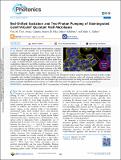Files in this item
Red-shifted excitation and two-photon pumping of biointegrated GaInP/AlGaInP quantum well microlasers
Item metadata
| dc.contributor.author | Titze, Vera M. | |
| dc.contributor.author | Caixeiro , Soraya | |
| dc.contributor.author | Di Falco, Andrea | |
| dc.contributor.author | Schubert, Marcel | |
| dc.contributor.author | Gather, Malte C. | |
| dc.date.accessioned | 2022-05-04T10:30:19Z | |
| dc.date.available | 2022-05-04T10:30:19Z | |
| dc.date.issued | 2022-03-16 | |
| dc.identifier | 277738376 | |
| dc.identifier | dd263e08-a59b-40e0-95f5-827eb0d08528 | |
| dc.identifier | 85125369996 | |
| dc.identifier | 000776221600029 | |
| dc.identifier.citation | Titze , V M , Caixeiro , S , Di Falco , A , Schubert , M & Gather , M C 2022 , ' Red-shifted excitation and two-photon pumping of biointegrated GaInP/AlGaInP quantum well microlasers ' , ACS Photonics , vol. 9 , no. 3 , pp. 952-960 . https://doi.org/10.1021/acsphotonics.1c01807 | en |
| dc.identifier.issn | 2330-4022 | |
| dc.identifier.other | ORCID: /0000-0002-7338-8785/work/108508483 | |
| dc.identifier.other | ORCID: /0000-0002-4857-5562/work/108508636 | |
| dc.identifier.other | ORCID: /0000-0002-8739-4852/work/108508674 | |
| dc.identifier.other | ORCID: /0000-0003-4605-957X/work/108508936 | |
| dc.identifier.other | ORCID: /0000-0003-0724-7084/work/108508962 | |
| dc.identifier.uri | https://hdl.handle.net/10023/25277 | |
| dc.description | This work received financial support from the Leverhulme Trust (RPG-2017-231), European Union’s Horizon 2020 Framework Programme (FP/2014-2020)/ERC grant agreement no. 640012 (ABLASE), EPSRC (EP/P030017/1), and the Humboldt Foundation (Alexander von Humboldt professorship). MS acknowledges funding by the Royal Society (Dorothy Hodgkin Fellowship, DH160102; Research Grant, RGF\R1\180070; Enhancement Award, RGF\EA\180051). ADF acknowledges support from European Research Council (ERC) under the European Union Horizon 2020 research and innovation program (Grant Agreement No. 819346). | en |
| dc.description.abstract | Biointegrated intracellular microlasers have emerged as an attractive and versatile tool in biophotonics. Different inorganic semiconductor materials have been used for the fabrication of such biocompatible microlasers, but often operate at visible wavelengths ill-suited for imaging through tissue. Here, we report on whispering gallery mode microdisk lasers made from a range of GaInP/AlGaInP multi-quantum well structures with compositions tailored to red-shifted excitation and emission. The selected semiconductor alloys show minimal toxicity and allow fabrication of lasers with stable single-mode emission in the NIR (675 – 720 nm) and sub-pJ thresholds. The microlasers operate in the first therapeutic window under direct excitation by a conventional diode laser and can also be pumped in the second therapeutic window using two-photon excitation at pulse energies compatible with standard multiphoton microscopy. Stable performance is observed under cell culturing conditions for five days without any device encapsulation. With their bio-optimized spectral characteristics, low lasing threshold and compatibility with two-photon pumping, AlGaInP-based microlasers are ideally suited for novel cell tagging and in vivo sensing applications. | |
| dc.format.extent | 9 | |
| dc.format.extent | 4138213 | |
| dc.language.iso | eng | |
| dc.relation.ispartof | ACS Photonics | en |
| dc.subject | Microlasers | en |
| dc.subject | Quantum wells | en |
| dc.subject | III-V semiconductors | en |
| dc.subject | Cell tracking | en |
| dc.subject | Two-photon excitation | en |
| dc.subject | QC Physics | en |
| dc.subject | DAS | en |
| dc.subject.lcc | QC | en |
| dc.title | Red-shifted excitation and two-photon pumping of biointegrated GaInP/AlGaInP quantum well microlasers | en |
| dc.type | Journal article | en |
| dc.contributor.sponsor | European Research Council | en |
| dc.contributor.sponsor | EPSRC | en |
| dc.contributor.sponsor | The Royal Society | en |
| dc.contributor.sponsor | European Research Council | en |
| dc.contributor.sponsor | The Royal Society | en |
| dc.contributor.institution | University of St Andrews. School of Physics and Astronomy | en |
| dc.contributor.institution | University of St Andrews. Centre for Biophotonics | en |
| dc.contributor.institution | University of St Andrews. Sir James Mackenzie Institute for Early Diagnosis | en |
| dc.contributor.institution | University of St Andrews. Biomedical Sciences Research Complex | en |
| dc.identifier.doi | https://doi.org/10.1021/acsphotonics.1c01807 | |
| dc.description.status | Peer reviewed | en |
| dc.identifier.grantnumber | 640012 | en |
| dc.identifier.grantnumber | EP/P030017/1 | en |
| dc.identifier.grantnumber | RGF/R1/180070 | en |
| dc.identifier.grantnumber | 819346 | en |
| dc.identifier.grantnumber | RGF/EA/180051 | en |
This item appears in the following Collection(s)
Items in the St Andrews Research Repository are protected by copyright, with all rights reserved, unless otherwise indicated.

